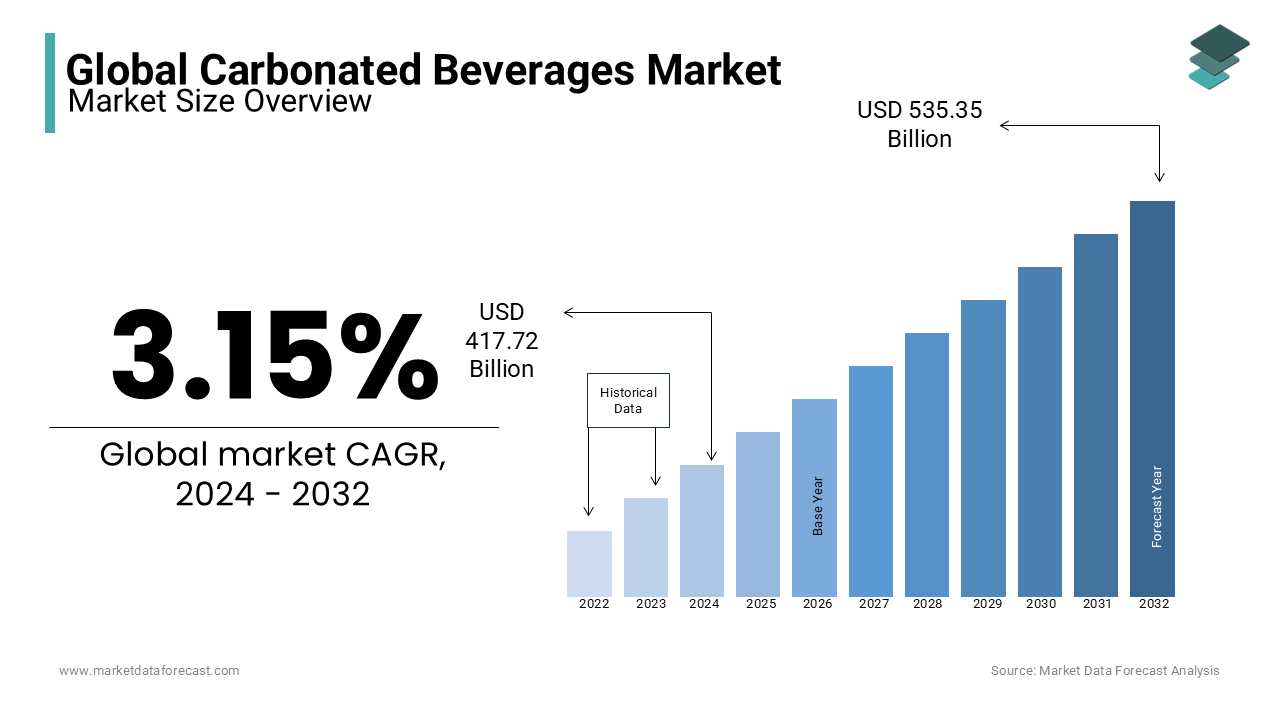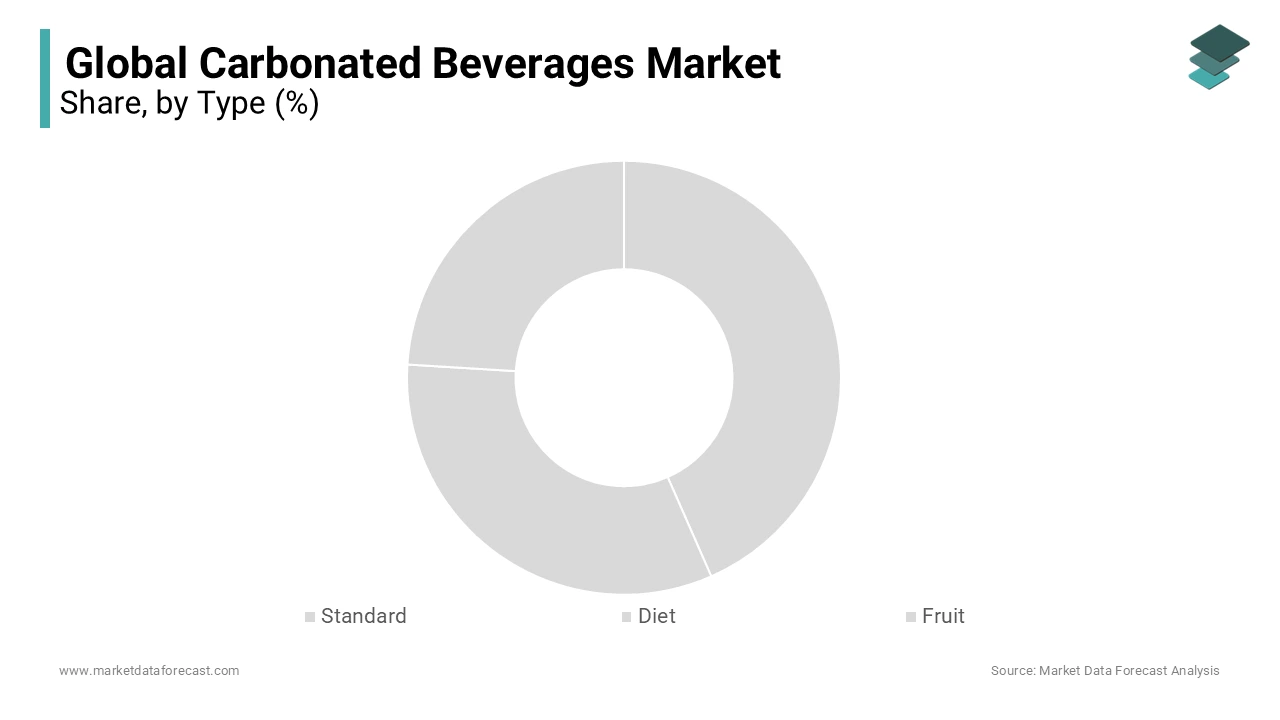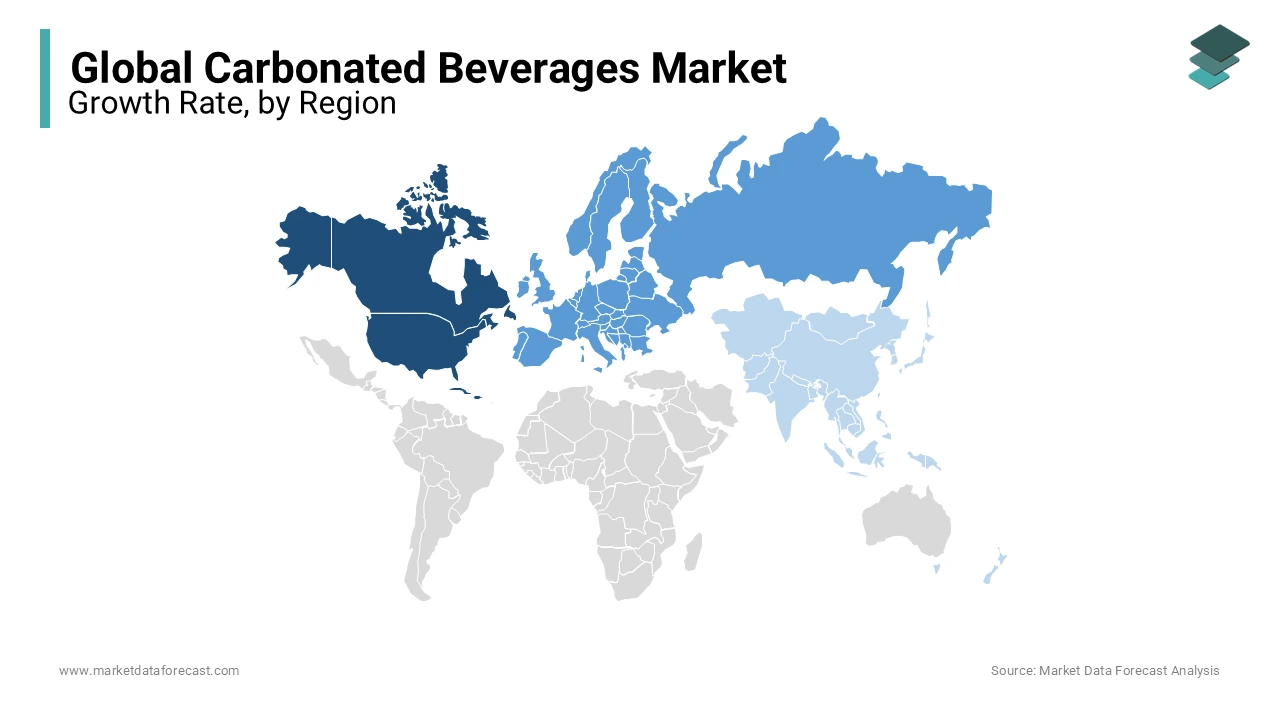Global Carbonated Beverages Market Size, Share, Trends, & Growth Forecast Report – Segmented By Type (Standard, Diet), Flavour (Cola, Lime, Orange), Distribution Channel (Independent Retailers, Convenience Stores, Hypermarkets And Supermarkets), And Region (North America, Europe, APAC, Latin America, Middle East And Africa) – Industry Analysis From 2025 To 2033
Global Carbonated Beverages Market Size
The size of the global carbonated beverages market was valued at USD 417.72 billion in 2024. The global market is expected to grow at a CAGR of 3.15% from 2025 to 2033 and be worth USD 552.22 billion by 2033 from USD 430.88 billion in 2025.

Carbonated beverages are liquids with the addition of carbon dioxide under pressure to provide effervescence. Soda water or sparkling water is used as the basis for making these drinks. Carbonated beverages contain sweeteners, spices, and water. Carbonic acid is produced by adding water and carbon dioxide that itches after consumption. Various types of carbonated drinks, such as sparkling water, tea, smoothies, and juices, are available in the market. Soft drink consumption is highest in the summer months and comes in a variety of flavors such as cola, orange, and lemon. They have a significant amount of sugar. In this line, there is a continuous diversification of products and new natural flavors are introduced. However, traditional flavors dominate the market. They are packaged drinks that are available in bottles, cans, and PET bottles without any alcohol content. Therefore, it is called a soft drink and covers smoothies, juices, teas ready-to-drink coffees, concentrates, and functional beverages.
MARKET DRIVERS
The growing consumption of carbonated beverages among the increasing youth population in developing countries and rising disposable incomes among consumers are propelling the global carbonated beverage market growth.
The rise in the carbonated beverages market around the world is likely to witness steady growth as the market is in the saturation stage in different parts of the world. The sales of carbonated beverages depend heavily on the companies' ability to develop new products based on changing consumer needs. The increasing demand for processed foods and beverages, along with the growing population of BRICS countries, is expected to help the market. The industry has relatively low prices and margins compared to other consumer goods. Therefore, key industry participants focus on packaging innovation to achieve market gains along with sustainability. Coca-Cola Company balances the relationship between bottle sustainability and functional design. They discard brand stocks, and the bottles are more sustainable than regular PET bottles. The demand for carbonated beverages with reduced sugar content is supposed to appeal to consumers due to new perceptions of health worldwide. There are various flavors like orange, cola and lemon. However, the original soft drink sector is dominant in terms of demand.
With increasing health awareness among consumers, naturally flavored drinks such as tropical and super fruits have been introduced. Product innovation and the transitional approach to innovative packaging and reusable bottle and can manufacturing are expected to provide ample opportunities for market participants. This phase is expected to reduce the dumping of waste material and ensure market continuity. The increase in the popularity of soft drinks, especially among young people, is a significant factor driving the growth of the global Carbonated Beverages market. Carbonated drinks improve the swallowing ability of young adults and young adults. It also makes you feel full because it stays longer than water in the human system.
The increasing frequency of serving carbonated beverages as side dishes at various fast food restaurants and cafes is also driving growth in the global carbonated beverages market. Growing consumer demand for mortgage and diet soda as the adoption of a healthy lifestyle increases is another factor driving growth in the global carbonated drinks market size. Furthermore, the growth of young populations and the increase in disposable income in developing countries are factors that are likely to drive the demand in the world market in the near future.
MARKET RESTRAINTS
Health lobbyists are one of the major restraints to the growth of the global carbonated beverages market. Reports of childhood obesity have increased in recent years. This can negatively affect the overall growth of the market. Strict regulations on the use of plastics in packaging materials appear as obstacles and can limit the global market growth. Additionally, the high sugar content in carbonated beverages can lead to diabetes, obesity, and calcium depletion. This factor can impede the growth of the global carbonated beverage market. The rising number of people consider carbonated beverages unhealthy and replace them with alternative beverages available in stores that are not harmful, which is solely to degrade the growth rate of the market. Nowadays, people are more concerned with maintaining a healthy diet and completely avoiding drinks like soda and other carbonated beverages that contain highly sweetened ingredients. These changes in consumer preferences are strongly impeding the growth rate of the market. People suffering from type 2 diabetes, cardiovascular disorders, or any other chronic illness should completely avoid consuming carbonated beverages as it elevates the risk factors, even to death. In a few cases, it has completely degraded the growth rate of the market.
MARKET OPPORTUNITIES
Companies’ innovative ideas to launch carbonated drinks with a permittable ratio of the ingredients are likely to promote the market’s growth rate. The launch of vegan or plant or fruit-based extracted carbonated beverages by the companies is attracting a huge number of customers. People are more inclined to choose a variety of flavored carbonated beverages where the taste of interests is continuously changing, potentially to gear up new opportunities for the carbonated beverages market. The trend towards adding naturally sweetened ingredients instead of artificial ones in accordance with the customer’s preferences towards natural drink options is additionally styling up growth opportunities for the market. Also, the penetration of the food delivery applications is sourcing to elevate the growth opportunities for the carbonated beverages market.
MARKET CHALLENGES
Getting approvals from government officials for newly launched carbonated beverages is very tough, which is a key challenging factor for the market to grow. In favor of public health safety, government officials are imposing stringent rules and regulations to give acceptance for the new products, which is slowly degrading the growth rate of the market. The launch of new flavored carbonated beverages according to the customer’s health benefits choices is really a tough sign for the companies. Launching healthier and sustainable products in accordance with the health benefits is conquered by showcasing huge difficulties in manufacturing the beverages, which also acts as a big barrier for the market key players.
REPORT COVERAGE
|
REPORT METRIC |
DETAILS |
|
Market Size Available |
2024 to 2033 |
|
Base Year |
2024 |
|
Forecast Period |
2025 to 2033 |
|
CAGR |
3.15% |
|
Segments Covered |
By Flavor, Type, Distribution Channel, And Region |
|
Various Analyses Covered |
Global, Regional and Country Level Analysis; Segment-Level Analysis; DROC; PESTLE Analysis; Porter’s Five Forces Analysis; Competitive Landscape; Analyst Overview of Investment Opportunities |
|
Regions Covered |
North America, Europe, APAC, Latin America, Middle East & Africa |
|
Market Leaders Profiled |
Britvic PLC, Cott Corporation, PepsiCo, Parle Agro, And Coca-Cola Company |
SEGMENTAL ANALYSIS
Global Carbonated Beverages Market Analysis By Type

The standard carbonated beverages market is leading with the largest share from recent years, whereas the diet segment is expected to hit the highest CAGR by the end of 2029. Standard carbonated beverages are like plain soda without any mix of flavors, like just sparkling water. Diet carbonated beverages are a mix of various flavors that are gaining huge positive responses from consumers, which is probably to elevate the growth rate of the segment. Fruit carbonated drinks are eventually growing in these years with the shifting trend towards fruit extracted drinks to maintain a balanced diet, which is subjected to fuel the growth rate of the fruit segment in this forecast period.
Global Carbonated Beverages Market Analysis By Flavour
The cola segment has had the most dominant share of the carbonated beverages market for many years and continues to grow at the same rate during this period. Cola carbonated drinks have been very famous for many years, and top companies like Coca-Cola mass produce, which is one of the manufacturers of cola carbonated drinks. There are many other companies that have prominence in the sales of cola carbonated drinks with similar flavors, which is attributed to leveling up the market’s growth rate. The lime and orange flavored segment is likely to have huge growth opportunities in the future period with the rising consumer demand for different flavored beverages in today’s world.
Global Carbonated Beverages Market Analysis By Distribution Channel
The hypermarkets and supermarkets segment is attributed to holding the largest share of the market. The growing number of stores, especially in urban cities, is ascribed to bolstering the growth rate of the carbonated beverages market through hypermarkets and supermarket distribution channels. Convenience stores are also to provide certain growth opportunities for the market during 2024 to 2029.
REGIONAL ANALYSIS

North America accounted for the largest share in terms of sales in the global market in 2023 and is predicted to maintain its position over the forecast period due to the presence of the leading manufacturing companies in the region. North America has a significant share of the global business. The growing demand for processed foods and beverages in the industry is assumed to have a positive impact on local markets. A growing number of working-class women in developed countries like the US and Canada is likely to show innovative opportunities for the carbonated beverages market in the North American region. People in developed countries have busy routines every day, which is why they rely on eating ready-to-eat or processed food products or beverages, as they do not have time to make fresh fruit, juices, or food. However, cases of obesity in the region have led to a steady decline in demand for ten years. Likewise, coming up with the innovative launch of carbonated beverages in favor of obese people with natural ingredients with low or no additional sweeteners will boost the growth rate of the carbonated beverages market in the coming years. According to the data report from the World Population Review, the US ranks first in the list of top carbonated beverage consumers such as Coke. In 2024, it was reported that 39,300 million liters of sugary soda were consumed by Americans, surpassing the previous records, which poses several opportunities for the market key players in this country.
Europe is projected to occupy the second position in the income category as the consumption of soft drinks by individuals increases, especially in restaurants and food stores. Europe, led by Germany, France, Italy, and Spain, is a market for soft drinks. The initial adoption of soft drink-based products combined with high living standards compared to developing countries is an essential factor responsible for market development. Germany's carbonated beverages market is holding a significant share owing to the rising number of consumers drinking beverages like soda with different flavors. Research studies reveal that the German people love carbonated drinks more than any other drinks, and the launch of innovative flavored drinks is attributed to escalating the growth rate of the market in Germany.
The Asia-Pacific region is anticipated to see a significant increase in profits during the prediction period due to the rising youth population and the rise of fast food in the area. The Asia Pacific market is expected to show the most rapid growth in the next seven years. Lowering strict rules and regulations and increasing disposable incomes among consumers in emerging countries such as China, India, Southeast Asia, Korea, and Japan are supposed to help overall growth. In Central and South America, growth is foreseen due to lower medical awareness compared to other regions that lack regulatory policies related to sugar-based beverages. Additionally, the companies in this area have focused on introducing new products, which are likely to spur growth.
KEY PLAYERS IN THE GLOBAL CARBONATED BEVERAGES MARKET
Britvic PLC, Cott Corporation, PepsiCo, Parle Agro and Coca-Cola Company are a few of the noteworthy companies in the global carbonated beverages market.
RECENT HAPPENINGS IN THE MARKET
In 2024, Britvic PLC and Carlsberg agreed to the integration with a deal of £3.3 Billion. These two companies have now been integrated and will be named Carlberg Britvic in the United Kingdom. Carlsberg invests huge amounts in improving the infrastructure and supply chain of the Britvic company, and that is ascribed to launching the most innovative products in the coming years. These companies are very confident in defining their position in the marketplace and becoming one of the leading brands within no time.
DETAILED SEGMENTATION OF GLOBAL CARBONATED BEVERAGES MARKET INCLUDED IN THIS REPORT
This research report on the global carbonated beverages market has been segmented and sub-segmented based on type, flavor, distribution channel, & region.
By Type
- Standard
- Diet
- Fruit
- Others
By Flavour
- Cola
- Lime
- Orange
- Others
By Distribution Channel
- Hypermarkets and Supermarkets
- Independent Retailers
- Convenience Stores
- Others
By Region
- North America
- Europe
- Asia Pacific
- Latin America
- Middle East and Africa
Frequently Asked Questions
1. What are the current trends in the carbonated beverages market?
The current trends in the carbonated beverages market are Health-conscious choices, a growing demand for low-calorie, sugar-free, and natural ingredient-based carbonated drinks, and Flavor innovation: Unique and exotic flavors, as well as nostalgic flavors, are becoming popular among consumers.
2. What are the key challenges faced by the carbonated beverages market?
The key challenges faced by the carbonated beverages market are Health concerns, negative perceptions regarding sugar content and artificial ingredients affecting consumer choices, and Regulatory pressures, including increasing regulations and taxes on sugary beverages in some regions, impacting market dynamics.
3. How is the market expected to grow in the coming years?
The market is expected to grow in the coming years. Emerging markets are Increased urbanization and rising disposable incomes in developing countries are driving market growth and Health awareness. As more consumers seek healthier alternatives, the demand for healthier carbonated beverages is expected to rise.
Related Reports
Access the study in MULTIPLE FORMATS
Purchase options starting from $ 2500
Didn’t find what you’re looking for?
TALK TO OUR ANALYST TEAM
Need something within your budget?
NO WORRIES! WE GOT YOU COVERED!
Call us on: +1 888 702 9696 (U.S Toll Free)
Write to us: [email protected]